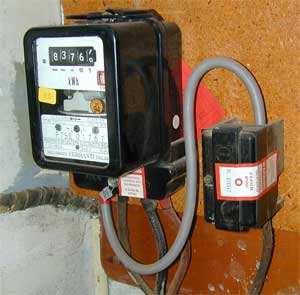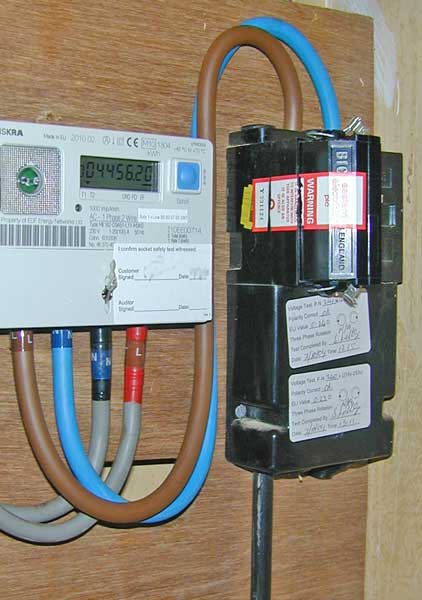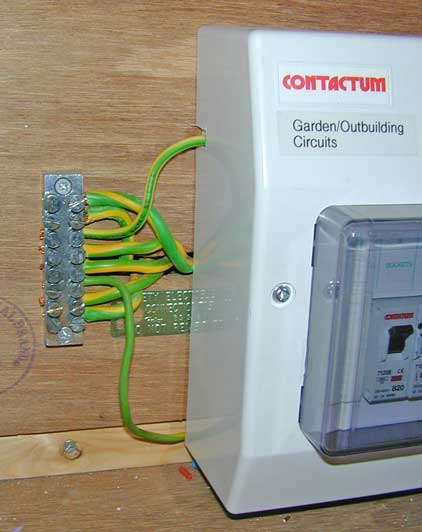Difference between revisions of "Earthing Types"
(→Identify your Earthing type: Added pics and descriptions for TT) |
|||
| Line 36: | Line 36: | ||
==Identify your Earthing type== | ==Identify your Earthing type== | ||
| + | |||
| + | ===TT Earthing=== | ||
| + | |||
| + | TT Systems are normally recognised by the lack of any earth connection to the incoming supply cable sheath or to the incoming neutral (i.e. combined earth and neutral) conductor. | ||
| + | |||
| + | An older example: | ||
| + | |||
| + | [[Image:MainCutoutandMeter.jpg]] | ||
| + | |||
| + | Here the incoming supply is by way of overhead cables. These terminate on the outside of the building and separate wires with fibre reinforced rubber insulation bring the supply into the building. The neutral connection is made directly to the meter, and the live connection is via a straightforward main cutout fuse and then to the meter. | ||
| + | |||
| + | A slightly more up to date TT installation: | ||
| + | |||
| + | [[Image:TTModern.jpg]] | ||
| + | |||
| + | Here the supply is again via overhead wires, but this time is converted to a concentric supply cable from the connection point outside the building to the main cutout. The cutout in this case is a more sophisticated device through which both neutral and live conductors pass. It has provision for the connection of an earth conductor the the incoming neutral when used on TN-C-S (PME) installations, however in this case you can see that the only connections actually used are the live an neutral feeds to the (electronic) meter. | ||
| + | |||
| + | ==Main Earthing Terminal== | ||
| + | |||
| + | The main earthing terminal (MET) in a building is the place where the main earth, the main equipotential bonding conductors, and the connection to the circuit protective conductors for installation's circuits meet. On smaller installations this will frequently be hidden away inside a consumer unit, where the main earth bus bar typically has addition connection points for the connection to the main earth, and also the bonding conductors. | ||
| + | |||
| + | On larger installations (often ones that employ more than one CU), the MET may be an external terminal block similar to that shown here: | ||
| + | |||
| + | [[Image:ExternalMET.jpg]] | ||
==See Also== | ==See Also== | ||
Revision as of 20:02, 20 October 2010
Earthing Types
BS 7671 lists five types of earthing system:
- TN-S
- TN-C-S
- TT
- TN-C
- IT
Where those letters indicate:
- T = Earth (from the French word Terre)
- N = Neutral
- S = Separate
- C = Combined
- I = Isolated
An explanation can be found here.
A useful IEE document on earthing (presumably most DIYers can ignore the section on earthing caravan pitches)
You can find details on installing a TT earth here.
Earthing types explained
TN-S
Earth connection provided by the supplier.
TN-C-S
Also known as PME, this earth connection is also provided by the supplier. Its direct connection to the neutral brings some added issues that require addressing at the consumer's end.
TT
Local earth connection, either to an earth rod, or in years past to a metal water pipe. Local earths typically have an earth impedance high enough that a short won't trip a 30A fuse, so TT installs have long required whole house RCD or ELCB protection.
TN-C
Not normally used.
IT
Never used for permanent house supplies, this is commonly used for portable generators. Simply there is no reliable earth connection on the system.
Identify your Earthing type
TT Earthing
TT Systems are normally recognised by the lack of any earth connection to the incoming supply cable sheath or to the incoming neutral (i.e. combined earth and neutral) conductor.
An older example:
Here the incoming supply is by way of overhead cables. These terminate on the outside of the building and separate wires with fibre reinforced rubber insulation bring the supply into the building. The neutral connection is made directly to the meter, and the live connection is via a straightforward main cutout fuse and then to the meter.
A slightly more up to date TT installation:
Here the supply is again via overhead wires, but this time is converted to a concentric supply cable from the connection point outside the building to the main cutout. The cutout in this case is a more sophisticated device through which both neutral and live conductors pass. It has provision for the connection of an earth conductor the the incoming neutral when used on TN-C-S (PME) installations, however in this case you can see that the only connections actually used are the live an neutral feeds to the (electronic) meter.
Main Earthing Terminal
The main earthing terminal (MET) in a building is the place where the main earth, the main equipotential bonding conductors, and the connection to the circuit protective conductors for installation's circuits meet. On smaller installations this will frequently be hidden away inside a consumer unit, where the main earth bus bar typically has addition connection points for the connection to the main earth, and also the bonding conductors.
On larger installations (often ones that employ more than one CU), the MET may be an external terminal block similar to that shown here:


